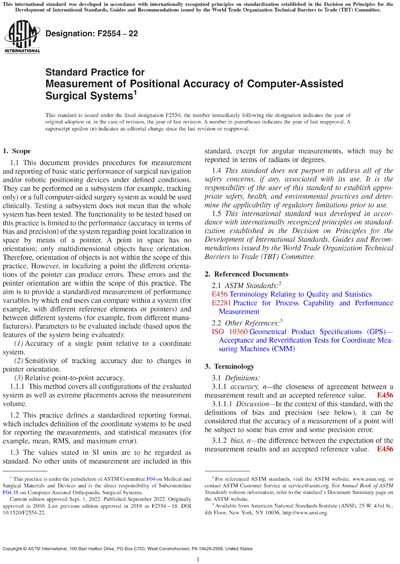Most recent
ASTM F2554-22
Standard Practice for Measurement of Positional Accuracy of Computer-Assisted Surgical Systems
1.1This document provides procedures for measurement and reporting of basic static performance of surgical navigation and/or robotic positioning devices under defined conditions. They can be performed on a subsystem (for example, tracking only) or a full computer-aided surgery system as would be used clinically. Testing a subsystem does not mean that the whole system has been tested. The functionality to be tested based on this practice is limited to the performance (accuracy in terms of bias and precision) of the system regarding point localization in space by means of a pointer. A point in space has no orientation; only multidimensional objects have orientation. Therefore, orientation of objects is not within the scope of this practice. However, in localizing a point the different orientations of the pointer can produce errors. These errors and the pointer orientation are within the scope of this practice. The aim is to provide a standardized measurement of performance variables by which end users can compare within a system (for example, with different reference elements or pointers) and between different systems (for example, from different manufacturers). Parameters to be evaluated include (based upon the features of the system being evaluated):
(1)Accuracy of a single point relative to a coordinate system.
(2)Sensitivity of tracking accuracy due to changes in pointer orientation.
(3)Relative point-to-point accuracy.
1.1.1This method covers all configurations of the evaluated system as well as extreme placements across the measurement volume.
1.2This practice defines a standardized reporting format, which includes definition of the coordinate systems to be used for reporting the measurements, and statistical measures (for example, mean, RMS, and maximum error).
1.3The values stated in SI units are to be regarded as standard. No other units of measurement are included in this standard, except for angular measurements, which may be reported in terms of radians or degrees.
1.4This standard does not purport to address all of the safety concerns, if any, associated with its use. It is the responsibility of the user of this standard to establish appropriate safety, health, and environmental practices and determine the applicability of regulatory limitations prior to use.
1.5This international standard was developed in accordance with internationally recognized principles on standardization established in the Decision on Principles for the Development of International Standards, Guides and Recommendations issued by the World Trade Organization Technical Barriers to Trade (TBT) Committee.
ASTM International [astm]

